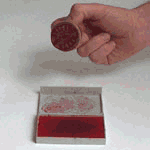Links
There is plenty of information about Mail Art on the web and the recently updated Mail Art page on Wikipedia provides a useful introduction. Here are links to some of the most informative sites that post calls for contributions.
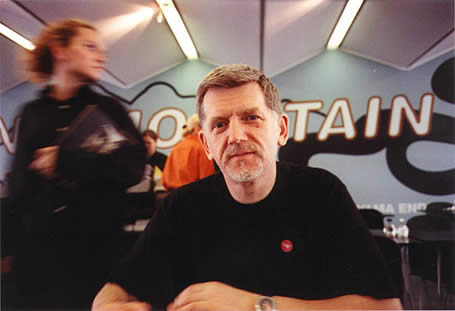
Interviewed by Kiyotei, 2004
Someone (Michael Leigh) referred to you as the mailart hermit. Is that a name you embrace? Why did you earn that moniker?
I don't mind the hermit tag, it comes from the heady days of Tourism and Mailart Congresses when I felt that meeting fellow mailartists was becoming an expectation. Some mailartists couldn't or didn't wish to visit or play host, I was simply saying 'that's OK too' at a time when I didn't hear anyone else saying it.
Why and when did you create your web site?
When computers and the internet became cheaper and more convenient. For years I was the Luddite King, internet access was very expensive, I suspect many mailartists couldn't afford computers, and anyway we really liked paper in those days.
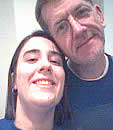
Then Leanda alerted me to the joys of things webtastic. I was a bit reluctant at first, but she helped me to see html as marginally more understandable than Klingon, and Fireworks & Dreamweaver as exciting rather than insurmountable. In 2000 I'd made a booklet about my two decades in mail art, and I decided to add more visuals and translate it into a website.
20 years in mailart is a long time. Do you remember your first piece of mailart (received or sent) and what was it?
I was introduced to mailart by Henryk Gajewski at an Open University summer school in Norwich. Our small group organised a mini on-campus mailart show, then each of us five novice networkers created a project proper. I was very into comics in 1983 and made the "Comic to Comic" project asking for a single 9cm square frame from each participant.
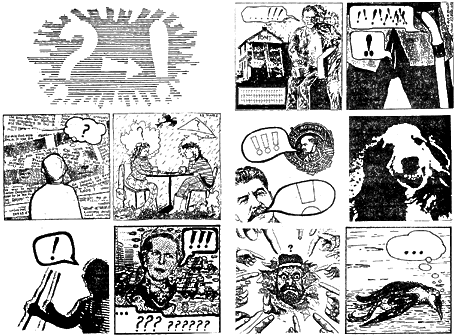
Tell me more about the Comic to Comic project. How did it work? How long did it take to finish? How many artists were involved?
I asked mailartists to send me one comic frame and then tackled how to make a comic book. There were about 70 contributions, which I thought was really great for a first project. Calls went out in August 1983 and I printed the comic on a cheapo offset litho machine in February 1984. Some of the frames were put together like an abstract strip cartoon with no narrative, some of the frames seemed to go together and suited a storyline. It was my first lesson in how disparate pieces can be forged into a coherent whole - I really enjoyed making that comic. My cover drawing included a tiny piece of everyone's contribution, an idea I returned to for my Elements project in 1986 which requested three snippets from contributors - visual artwork, written words and a bit of audio on cassette tape - from the contributions I made drawings and a big oil painting (which Crackerjack Kid saw and said "I thought it was bigger"), an illustrated story (written with Fergus Stewart) and a cassette of songs and audio art.
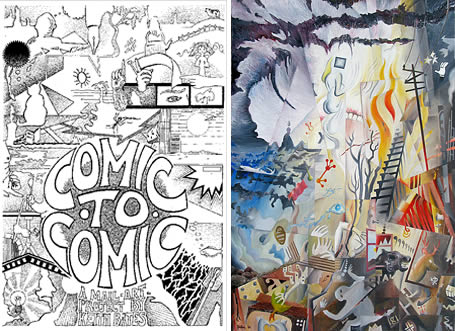
Do you still correspond with the same artists of 20 years ago?
With some of them yes! Creative Thing, Jacques Massa, Guy Bleus, Michael Leigh, A. D. Eker. Some others too. For my 2004 project , the Mailart Typeface, I made sure I included some of my oldest mailart friends. I not only tried to make the fonts quite historical, malilart-wise, but also a piece of personal mapping. I enjoyed assigning certain characters to mailartists I've known for a while - like giving the delete key to GX Jupitter-Larsen who sent back an empty envelope, and allocating the @ symbol to Ruud Janssen, an early advocate of the internet and email.
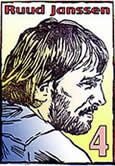
You also lose contact with mailartists - it's an organic flux, it's life, and sometimes you don't keep mailarting people who have influenced and impressed you greatly. The Mailart Graphics font was a personal journey, made up of images from my computer scrapbook, stamps and symbols; it allowed me to include artists who have died as well as the living. I could have made that font twice over. How could I omit Lon Spiegelman for instance! I did include my favourite 'Obscurity' stamp from Norman Solomon (Mr Postcards), we stopped corresponding a decade ago, then I read on Ruud Janssen's site that he died in 2000.

Many mailartists complain about the Internet's influence on the process of mailart and communication. Many believe that only paper (real) correspondence is of any value to the mailart ideal. Many believe that digital art and e-mail art is not as important (vital/good) as snail mail correspondence. Do you think these feelings are legitimate or are they just whiney comments from people who don't understand the Net and fear its increasing influence on communication and the arts?
Well, I used to sympathise greatly with the traditionalists, mailart's roots are 'hands-on' and paper-based. Not all mailartists have been able to afford the whole computer/internet package even if they realised its potential, cheap internet access certainly took a while to arrive in the UK. I recall when Tourism threatened to become the mail art obligation of the 1980s, and I suppose I was aware that internet access was the increasing expectation of the 1990s and we shouldn't forget that not everyone can be, or wishes to be, on-line. In the 2000s we seem to have arrived at the point where email and the internet are often the only way to learn about new mailart actions and there seems little point bemoaning it.
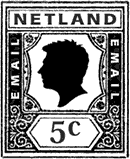
I think we need to treat email as mail, emailart as mailart. Different carrier but still mail, equally as valid. Different qualities - better in some respects, lacking in others. It now seems rather anachronistic for mail art calls on the web to specify that contributions must arrive by snailmail. If emailart is to become as accepted as mailart, we need to make attachments as welcome as postcards.

Did you ever correspond with Ray Johnson?
For the first few years I was not very aware of Ray Johnson, I was introduced to pragmatic networking via active mailart virgins who were as crazy about the idea as I was. I learned about Ray gradually. In 1991 John Held Jr sent me a Ray Johnson envelope, which I still have, for my "Jackson Pollock's Shoes" project about accidental masterpieces by famous artists. Right at the end of 1994 I was planning a project called "Artists' Cheques" (Artsistchecks), a sort of investigation into the "do mail art and money mix?" question using the bank cheque format. I plucked up courage and sent Ray Johnson an invitation. Ray's cheque never arrived, I guess he had something else on his mind.
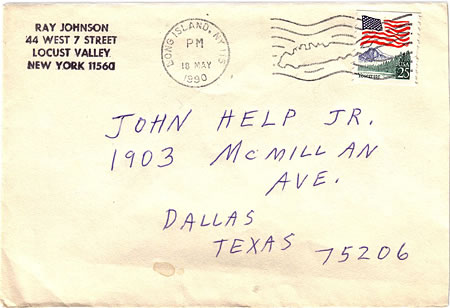
What are your hobbies or interests?
Mailart is still up there, and I hope the internet and email may have added fuel to the fire? Then there's music - I like to play guitar and even sing, I bought Logic Express to record on my Mac. I want more where 'Mail box Friends' and 'Scum Boat Gate' came from. I've also really enjoyed learning about the web and making my sites. Tickets have been something of a passion, and of course there's fonts. I've long loved lettering, but typefaces have always been what other people created, until I discovered Fontographer in 2001. Apart from the artistification I love science fiction and fantasy TV and film. I could watch Star Treks forever. My son Alex, and the mailartist Lunar Suede who worked on some seasons, got me into Stargate a bit late in the day. I thought Buffy the Vampire Slayer was superb television. I am also very excited about the BBC starting up production of Dr. Who again - even more excited because Christopher Eccleston, who I taught at high school, has been chosen to play the doctor. Forget all the mailart stuff, my claim to fame is "I taught Dr. Who".
What are 'Mail box Friends' and 'Scum Boat Gate'?
I've occasionally been inspired to write songs and music about mail art. 'Mailbox Friends' was a "wow, look what I've found!" song - a celebration of newlywed networking from 1984. I love the middle bit which are lines borrowed from a Robin Crozier audio tape - the "hello can you hear me , hear me from the past, hear me in the future".
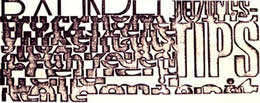
In the 1990s I taught a class of year 9 students about different kinds of distortions and used the South American mailartist Damaso Ogaz's 'Escritura' works as an example of cut and paste juxtapositions - in response one of the class came up with a newspaper collage of the three words 'Scum Boat Gate' - I loved the evocative quality of that name, it felt like a romantic place from my childhood, an adventure I never had. The name hung around in my head for a few years and suddenly the song practically wrote itself.
What was the most interesting (surprising, wacky or fun) thing you have received in the mail?
Peter Kauffmann sent me his shoes. That was in 1991, for the 'Jackson Pollock's Shoes' project which I documented as a spoof Christie's auction catalogue. Peter's response was literal, but surprising and memorable! H.R. Fricker sent me £50 to encourage me to visit him in Switzerland, but I couldn't bring myself to cash the cheque. Ryosuke Cohen sent a life size self portrait. Some of the smallest things in mailart are the most endearing - a stamp, a rubberstamp, a tiny drawing, an envelope. As part of the Mailart Typeface project (2004), I made a 'Mailart Graphics' font, and over several months I spent many a rewarding evening sorting through twenty years of networking looking for the magical, tiny images that could be used in a picture font.
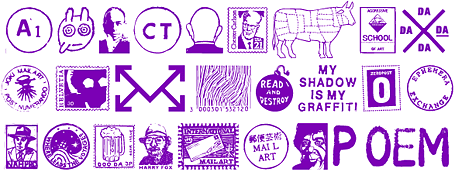
Do you think artists have a duty to be political?
I don't think you can dictate such things to artists of all people. It might be more useful to think of artists having a duty to themselves, to follow their own threads of enquiry that might with luck produce results that interest, amuse, enlighten or influence others. It's hard to see how that can fail to be political at some level, everyone is somewhere between propaganda and Play-Doh, some people shout soap-box-style, and others keep a diary.
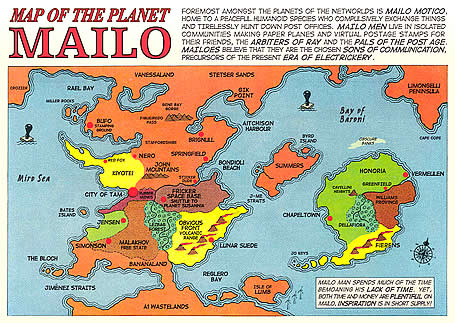
Do you trade ATCs (artist trading cards)?
I've made a few, but it's not been a format that's particularly excited me, which is weird because I have a bit of a theory about artists tending to revisit childhood fascinations. Stamps, tickets, comics, maps, lettering - they all caught my childhood imagination and have continued to feed my adult creativity. I also collected chewing gum cards - I have a full set of original Mars Attacks cards from the sixties, lots of others too - but the Artists' Trading Cards boom never really hooked me somehow.
Describe the city where you live.
Manchester is a pretty good place to be. I moved here from Liverpool in the early seventies and didn't really think much of the city centre back then, Liverpool had more character, Manchester had the grimy legacy of being the world's first industrial city.
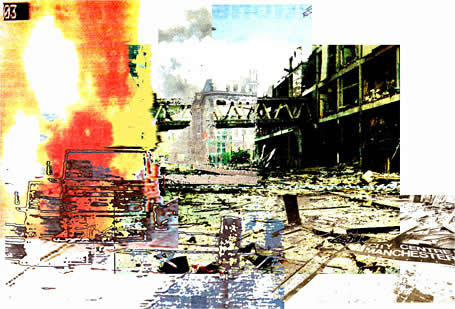
Since the IRA bomb in 1996, there seems to have been a real renaissance. Not only some good restoration, new leisure facilities, and better shopping, but also a vibrancy and buzz, even a rediscovered sense of identities and ownerships. Northern Quarter regeneration, Urbis Museum of the City (good Peter Saville exhibition recently), Printworks, new Mancester Art Gallery, even bigger University. It rains as well. Not particularly more than elsewhere, but probably more often. Add to that a smattering of the Smiths, Happy Mondays, Badly Drawn Boy, Granada TV, Cosgrove Hall, and Manchester United Football Club, and I'm sounding dangerously like the City Council's Tourism Department. It's not New York, but it's not bad. I saw Simon & Garfunkel at the Manchester Evening News Arena last month.
Did you know the fab four back in Liverpool?
I'm afraid not, although I did live literally around the corner from Paul McCartney in the early 1960s - I lived in Yorkaster Road, and his family lived in Forthlin Road, in a small council house that's now owned by the National Trust. I remember some of the kids getting excited when the Beatles visited the McCartney house, though I was a bit young to appreciate how big they were becoming.
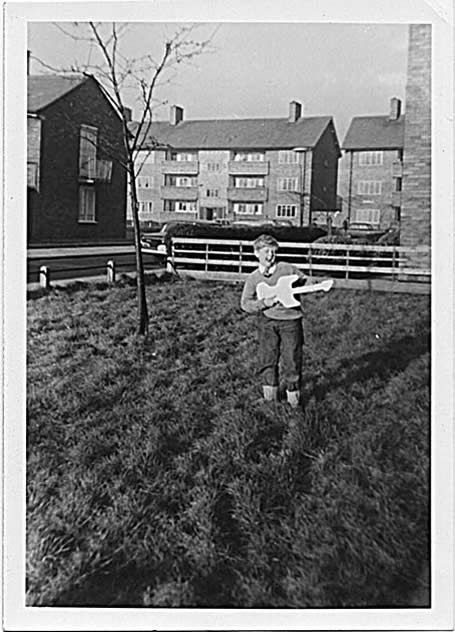
Here is a photo of the young Keith Bates outside our maisonette pretending to be a pop singer with a cardboard cut-out guitar. Behind me is Forthlin Road, turn right for guided tours of Macca's house. I was that close to being the fifth Beatle!
Why the facination with fonts?
I've loved lettering for as long as I can remember. I discovered the existence of Fontographer four years ago and although I've always found the vector drawing tools of Illustrator and Freehand difficult to use, for some reason I found Fontographer's drawing tools much nicer and cuddly. I worked my way through Chank Diesel's website tutorial and I felt like a god tinkering with the atoms of the Univers. I've made quite a few fonts in three years, and it's been nice to actually sell the odd one! There are also quite a few freebies on the K-Type website, including Lexia readable, based on the loved or loathed Comic Sans. Working in education where Comic Sans is recommended by educationalists for its legibility, I noticed that the font was routinely being used inappropriately for official documents. Comic Sans is too whimsical for many uses, and I wondered if adolescents or adults with literacy difficulties could feel patronized. So I used Comic Sans as the basic model for legible weight and spacing, but removed the sometimes problematical American childrens' comic book style in favour of more grown-up contemporary typographical elements, whilst still keeping a slightly hand-drawn feel.
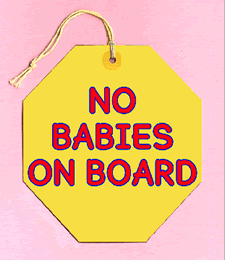
I recently posted information about it on the Typophile website and Vincent Connare, the designer of Comic Sans (and the altogether lovelier Trebuchet), wrote that there is already a Lexia typeface, so he suggested calling it "Our Kid". I replied that I might consider changing the name to "Comic Sons".
Do you have any pets? What are they?
I used to have a cat called 'Cat' (named after the singer Cat Stevens who is apparently no longer allowed into the USA because he changed his name to Islam.) Cat died four years ago and is buried in the garden (my ex pet, not Cat Stevens). I currently have a pet spider called Nigel.
What modern figures do you most admire and why?
I could do you a list if you want, like the Beatles made for Peter Blake when designing the Sgt Pepper sleeve? It would probably start off with the Beatles and Peter Blake, and then continue with Paul Simon and Richard Hamilton. Although the figures one admires changes with time, my heroes tend to be the people I admired when I was 20, when I was trying to make sense of my own life choices; the artists and musicians I liked were my guides. I remember in my twenties having several wish-fulfilment dreams about actually meeting Paul Simon. Later, maybe after meeting some famous mailartists and discovering that they were just ordinary people, I realised that meeting Paul Simon would be a shallow experience compared to playing 'The Only Living Boy in New York'. My list would include lots of mailartists, because they don't get paid for their passion and they get little recognition. I think there is a fine and fickle line between the acclaimed artist and the common creative.


